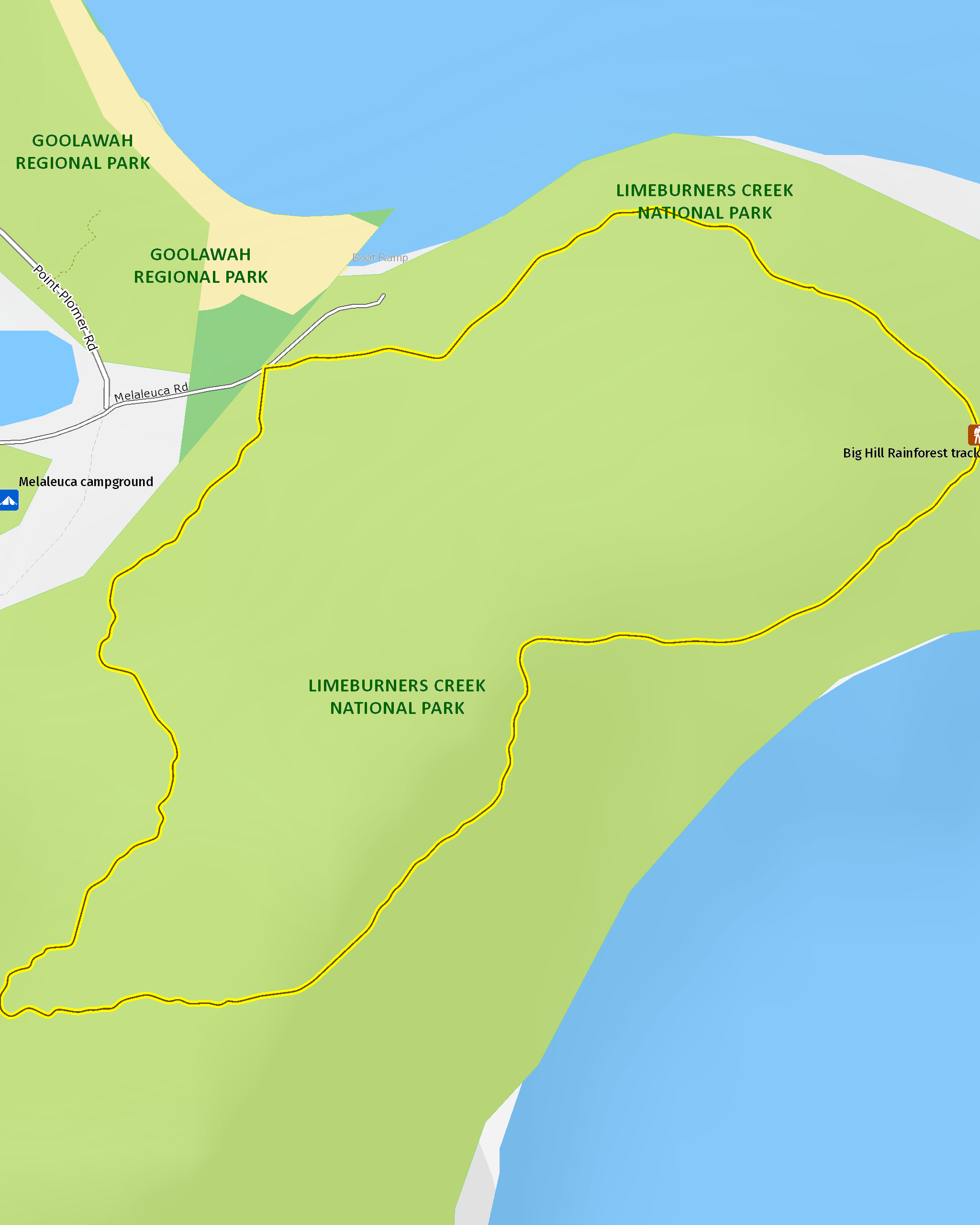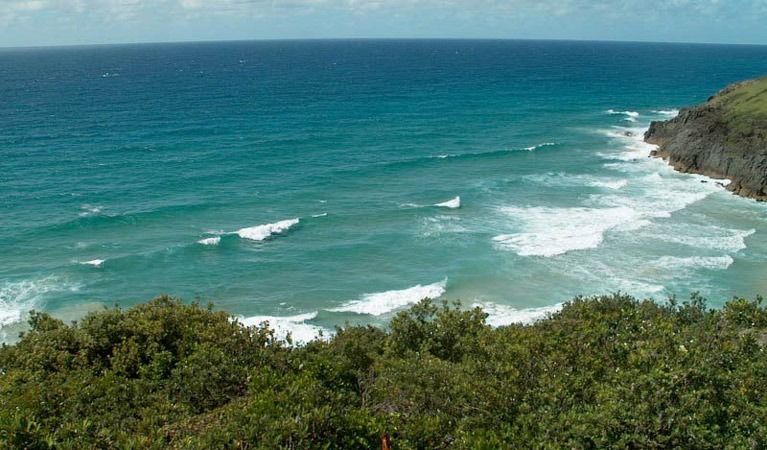Overview
Discover lush rainforest, rocky headlands, spectacular views and abundant wildlife along Big Hill Rainforest walking track.
- Distance
- 1.4km loop
- Time suggested
- 45min - 1hr
- Grade
- Grade 4
- Entry fees
- Park entry fees apply
- What to
bring - Hat, sunscreen, drinking water
- Please note
- Remember to take your binoculars if you want to birdwatch or whale watch.
Starting at the picnic area by the beach, this short loop trail winds around the top of the headland, providing sweeping views of the pristine coastline and rocky shores below.
Find a spot on the headland to sit and take in the untouched beauty around you. In winter and spring, it also makes for a great vantage point for whalewatching.
The walk meanders through low heath vegetation and pandanus palms before taking you into rare coastal rainforest. The strangler figs, coastal blackbutt and large variety of rainforest species create a striking backdrop for the abundance of wildlife and birds you’ll find in the rainforest. At sunset, you might even see microbats flying through the canopy.
Map

Map legend

Local alerts
For the latest updates on fires, closures and other alerts in this area, see https://www.nationalparks.nsw.gov.au/things-to-do/walking-tracks/big-hill-rainforest-walking-track/local-alerts
General enquiries
- National Parks Contact Centre
- 7am to 7pm daily
- 1300 072 757 (13000 PARKS) for the cost of a local call within Australia excluding mobiles
- parks.info@environment.nsw.gov.au
Park info
- in Limeburners Creek National Park in the North Coast region
Limeburners Creek National Park is always open but may have to close at times due to poor weather or fire danger
-
$8 per vehicle per day.
Buy annual pass.
Visitor info
All the practical information you need to know about Big Hill Rainforest walking track.
Track grading
Features of this track
Distance
1.4km loop
Time
45min - 1hr
Quality of markings
Limited signage
Experience required
No experience required
Gradient
Short steep hills
Steps
Occasional steps
Quality of path
Formed track, some obstacles
Getting there and parking
Get driving directions
Big Hill Rainforest walking track is in the northern precinct of Limeburners Creek National Park. To get there:
- Drive towards Crescent Head from Kempsey
- As you enter Crescent Head village, turn right into Point Plomer Road, also known as Bakers Road.
- Continue for approximately 14km along gravel road to Big Hill
Parking
Parking is available, near Big Hill beach and Melaleuca campground.
Best times to visit
There are lots of great things waiting for you in Limeburners Creek National Park. Here are some of the highlights.
Spring
Watch the heathland wildflowers burst with colour and enjoy long walks on the beach as you look out for whales in the distance.
Summer
Take the kids to Point Plomer for a family holiday by the beach, swimming by day and discovering the star-filled skies by night.
Winter
Take advantage of the better surf conditions in winter and a chance to spot whales on their migration north.
Weather, temperature and rainfall
Summer temperature
Average
17°C and 26°C
Highest recorded
42.3°C
Winter temperature
Average
7°C and 19°C
Lowest recorded
0°C
Rainfall
Wettest month
February
Driest month
August
The area’s highest recorded rainfall in one day
1387.6mm
Facilities
Drinking water is not available in this area, so it’s a good idea to bring your own.
Maps and downloads
Permitted
Fishing
A current NSW recreational fishing licence is required when fishing in all waters.
Pets
Dogs are permitted in the adjacent Goolawah Regional Park.
Prohibited
Learn more
Big Hill Rainforest walking track is in Limeburners Creek National Park. Here are just some of the reasons why this park is special:
A place of historic heritage

Back in the early days of the Port Macquarie penal settlement, lime for building mortar was in great demand. They used to collect and burn enormous quantities of oyster shells from this area, giving the park its unusual name. Many of the landmarks in the park were named after some of the more colourful pioneers of the past. Barries Bay was originally a whaling station, named after the Barrie family who lived there for many years. Big Hill was named after Kevin Hill, reputedly a hermit who lived on the northwest side of the hill during the Great Depression of the 1930s.
Strong Aboriginal cultural connections

The Dunghutti People from Kempsey and the Biripai people from Port Macquarie continue to have a strong connection with the area surrounding Limeburners Creek. Point Plomer and Big Hill in particular are Aboriginal sites of outstanding significance. Several sites and artefacts tracing Aboriginal settlement in this region back to at least 6,000 years have been found, including burial sites, shell middens, a quarry for stone tool production and axe grinding grooves in rock outcrops around Point Plomer.
Wildlife and bird watching haven

Limeburners Creek National Park is a hot spot for animals. Spotted tail quoll, dingos, butterflies, micro bats, giant pythons and even brolgas make their home here. Birdwatchers will also be in heaven. You'll see rare pied oystercatchers and little terns along beaches, osprey and other large birds of prey circling above and migratory seabirds on their journey north. You might also see the rare ground parrot out in the grass and heathlands.
- Big Hill Rainforest walking track Discover lush rainforest, rocky headlands, spectacular views and abundant wildlife along Big Hill Rainforest walking track.
- Multi-day pack free hike on NSW Mid-North Coast Journey through untouched, coastal landscapes on this 3-day, pack-free walk with Positive Energy Adventures and Retreats. You’ll walk 34km across the beautiful Limeburner’s National Park and Goolawah National Park.
Plants and animals protected in this park
Animals
-

Eastern ground parrot (Pezoporus wallicus wallicus)
The eastern ground parrot is a beautiful, ground-dwelling native bird that lives in low heathland habitat along the NSW North and South coasts and escarpments. It’s listed as a vulnerable species in NSW.

